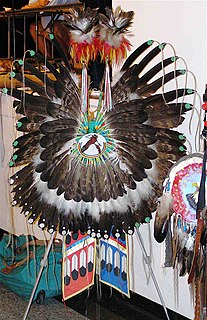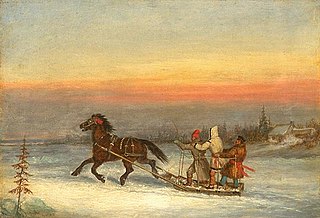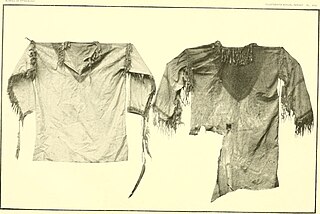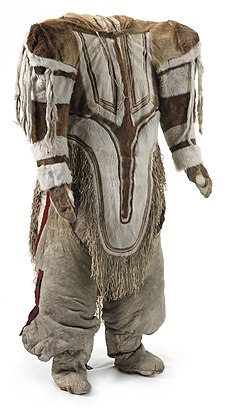 W
WBuckskins are clothing, usually consisting of a jacket and leggings, made from buckskin, a soft sueded leather from the hide of deer. Buckskins are often trimmed with a fringe – originally a functional detail, to allow the garment to shed rain, and to dry faster when wet because the fringe acted as a series of wicks to disperse the water – or quills. They also served as a form of camouflage when hunting, by breaking up the outline of the wearer and allowing them to blend in with their background.
 W
WA buffalo robe is a cured buffalo hide, with the hair left on. They were used as blankets, saddles or as trade items by the Native Americans who inhabited the vast grasslands of the Interior Plains. Some were painted with pictographs or Winter counts that depict important events such as epidemics, famines and battles.
 W
WThe Native American bustle is a traditional part of a man's regalia worn during a dance exhibition or wachipi and originates from the Plains region of the United States. In its modern form, the men's bustle is typically made of a string of eagle or hawk feathers attached to a backboard. Eagle and hawk feathers are sacred religious objects to Native American people and the possession of eagle and hawk feathers are protected by the eagle feather law.
 W
WA button blanket is wool blanket embellished with mother-of-pearl buttons, created by Northwest Coastal tribes, that is worn for ceremonial purposes.
 W
WA capote or capot is a long coat with a hood.
 W
WA coonskin cap is a hat fashioned from the skin and fur of a raccoon. The original coonskin cap consisted of the entire skin of the raccoon including its head and tail. Beginning as traditional Native American headgear, coonskin caps became associated with American and Canadian frontiersmen of the 18th and 19th centuries, and were highly popular among boys in the United States, Canada, the United Kingdom and Australia in the 1950s.
 W
WA dush-toh, also spelled dush-too, dush-tooh, or dush-tuh, is a customary Caddo hair ornament worn by girls and women during dances, particularly the Turkey Dance. Neighboring tribes, such as the Kickapoo and Delaware, have similar women's hair ornaments.
 W
WGhost shirts are shirts or other clothing items created by Ghost dancers and thought to be imbued with spiritual powers.
 W
WA Hudson's Bay point blanket is a type of wool blanket traded by the Hudson's Bay Company (HBC) in British North America and the United States during the 1700s and 1800s. The company is named for the Hudson Bay and the blankets were typically traded to First Nations in exchange for beaver pelts. The blankets continue to be sold by Canada's Hudson's Bay stores and have come to hold iconic status in Canada. In the United States they can be found at luxury department store and Hudson's Bay sister chain Lord & Taylor.
 W
WThe traditional skin clothing of the Inuit is a complex system of cold-weather garments historically made from animal hide and fur, worn by the Inuit, a group of culturally related indigenous peoples inhabiting the Arctic areas of North America and Greenland. The most basic traditional outfit consisted of a coat (parka), pants, mittens, inner footwear, and outer boots made of animal hide and fur. The most common sources of hide were caribou, seals and seabirds, although other animals were used when available. Production of warm, durable clothing was an essential survival skill for the Inuit, which was traditionally passed down from adult women to girls. Preparation of clothing was an intensive, weeks-long process that occurred on a yearly cycle following traditional hunting seasons. The creation and use of skin clothing was strongly intertwined with Inuit religious beliefs.
 W
WA Luckenbooth brooch is a Scottish heart-shaped brooch. These brooches often have a crown above one heart, or two intertwined hearts. They are typically made of silver and may be engraved or set with stones.
 W
WA manta is a rectangular textile that was worn as a blanket or as a wrap-around dress. When worn as a dress, the manta is held together by a woven sash.
 W
WA matchcoat or match coat is an outer garment consisting of a length of coarse woolen cloth (stroud), usually about 2 metres (7 ft) long, worn wrapped around the upper part of the body like a toga. Historically, they have been worn primarily by the Indigenous peoples of the Northeastern Woodlands, who may still wear them as regalia or for traditional events. The matchcoat might be worn by people of either sex. It was a common article of trade by the English and French with the peoples of several Nations.
 W
WA moccasin is a shoe, made of deerskin or other soft leather, consisting of a sole and sides made of one piece of leather, stitched together at the top, and sometimes with a vamp. The sole is soft and flexible and the upper part often is adorned with embroidery or beading. Though sometimes worn inside, it is chiefly intended for outdoor use. Historically, it is the footwear of many indigenous people of North America; moreover, hunters, traders, and European settlers wore them. Etymologically, the moccasin derives from the Algonquian language Powhatan word makasin, and from the Proto-Algonquian word *maxkeseni (shoe).
 W
WNavajo Dolls describe a style of clothing that Navajo women copied from east coast American society in the 1860s. Women of that era wore full dresses made out of satin. President Lincoln's wife and friends wore full dresses made of satin. Navajo women copied the patterns but substituted velvet for the satin and made buttons out of nickels and dimes. These stylish skirts are still fashionable today, for Navajos and non-Navajos alike.
 W
WA poncho is an outer garment designed to keep the body warm. A rain poncho is made from a watertight material designed to keep the body dry from the rain. Ponchos have been used by the Native American peoples of the Andes since pre-Hispanic time, from places now under the territory of Ecuador, Colombia, Bolivia, Argentina, Chile and Peru and are now considered typical South American garments.
 W
WRibbon work is an appliqué technique for clothing and dance regalia among Prairie and Great Lakes Native American tribes.
 W
WPorcupine hair roaches are a traditional male headdress of a number of Native American tribes in what is now New England, the Great Lakes and Missouri River regions, including the Potawatomi who lived where Chicago now stands. They were and still are most often worn by dancers at pow wows as regalia.
 W
WUnangan hunting headgear are wooden hats associated with the Unangan, the Indigenous peoples of what are currently known as the Aleutian Islands.
 W
WWar bonnets are feathered headgear traditionally worn by male leaders of the American Plains Indians Nations who have earned a place of great respect in their tribe. Originally they were sometimes worn into battle, but they are now primarily used for ceremonial occasions. In the Native American and First Nations communities that traditionally have these items of regalia, they are seen as items of great spiritual and political importance, only to be worn by those who have earned the right and honour through formal recognition by their people.
 W
WYup'ik clothing refers to the traditional Eskimo-style clothing worn by the Yupik people of southwestern Alaska.